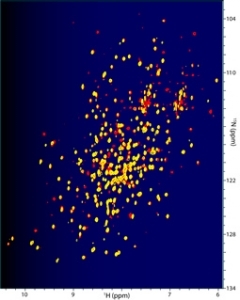
Dominique Frueh
Research Interests:
Our laboratory uses nuclear magnetic resonance (NMR) to study modulations of protein dynamics and conformations in active enzymatic systems.
Non-ribosomal peptide synthetases (NRPSs) are large enzymatic systems responsible for the biosynthesis of a wealth of secondary metabolites, many of which are used by pharmaceutical scientists to produce drugs such as antibiotics or anticancer agents. To synthesize all of these remarkably diverse compounds, bacteria and fungi use a surprisingly conserved strategy: NRPSs are organized in modules, made of conserved domains, that each incorporates a dedicated substrate. Thus, new compounds with improved activities can be generated, in principle, by swapping domains or modules in order to control substrate incorporation and hence the final product. To do this efficiently, a deep understanding of domain communication during the synthesis is required. NMR and crystallography studies indicate that domain interactions are transient and that their quaternary structure is likely subject to rearrangements during the synthesis. In addition, both techniques show that individual domains are subject to conformational heterogeneity. We principally use NMR to investigate inter- and intra-domain modifications occurring during the catalytic steps of non-ribosomal peptide synthesis. 
Development of NMR methods. The enzymatic systems that we investigate provide many challenges to NMR. Some of the domains or multi-domains are large, and therefore, the resulting data suffer from spectral crowding and signal losses. In addition, the proteins are subject to dynamics, which may further deteriorate the quality of the spectra.Consequently, new methods often need to be developed to overcome these challenges. The techniques provide means to assign the NMR signals to the atoms in the proteins, to measure structural constraints, or to monitor dynamics. When faced with an impasse, new techniques can be designed in our lab. With these new techniques available, new protein targets can be considered, thereby increasing our overall understanding of the systems. Thus, we foster a synergy between studies of relevant biological systems and the development of new NMR techniques.
